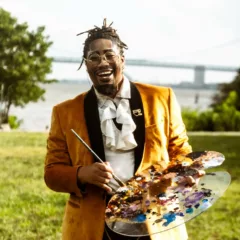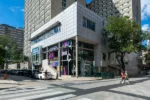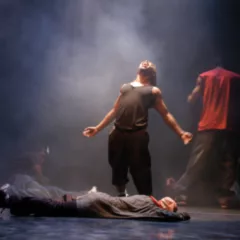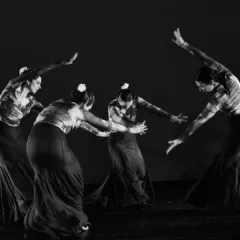One of the most unconventional places to view art this summer is the cruiser Olympia, docked on the Delaware River. Commissioned in 1895 and now part of the Independence Seaport Museum, Olympia is the oldest steel warship still afloat in the world–and now it is playing host to sculptural installations that show up in the most unlikely spaces, from officers’ cabins to bathrooms to the galley kitchen.
Spanning everything from traditional media like clay, wood, and textile, to more experimental forms like sound and digital projection, Artship Olympia is a wide-ranging group show with a few real standouts. The exhibition is organized by Philadelphia Sculptors, who invited 5 artists and selected the remaining 10 from an open juried process.
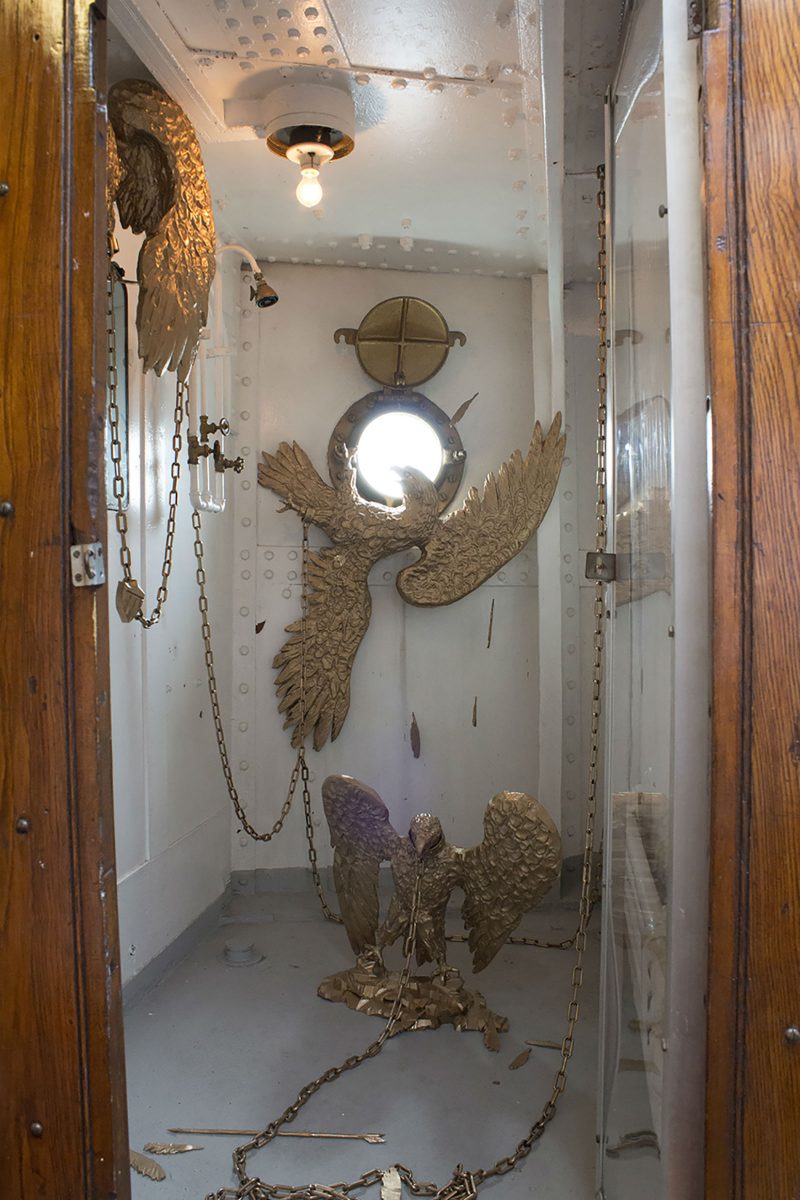
Going below
Unexpected surprises awaited me in the rabbit warren of tiny, overheated spaces in the Berth Deck, where both sailors and officers had their living quarters. I was struck by how Sarah Kate Burgess and Daniel Clark engage with the most mundane spaces of the ship, the bathrooms. Clark’s “The Bird Cage” uses the all-American motif of the eagle to explore the themes of conflicted masculinity and self-reflection in the private, enclosed space of the Officers Shower Room. A group of 3 golden eagles reminiscent of those that adorn 19th-century mirrors, only here made of carved and painted Styrofoam, are fastened to the walls of the claustrophobic space of the shower room. The birds struggle to escape their chains and fly out of the porthole, their violent desperation suggesting officers’ similarly thwarted desire to escape.
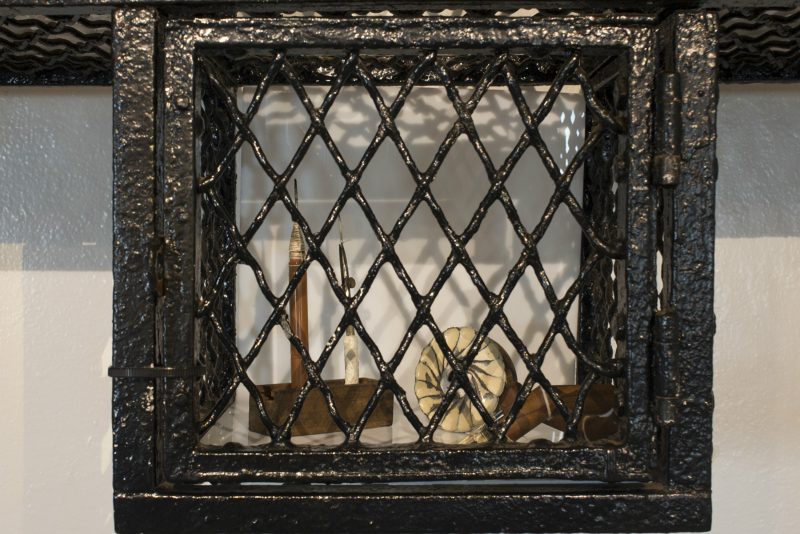
In the larger and less private space of the Sailors’ Bathroom, Sarah Kate Burgess’ “Hissed Between Blue Teeth” assembles a series of meticulously crafted tools used for personal adornment and hygiene, like an improvised tattoo needle made of sewing needles tightly bound together, an ink pot made from a barnacle, and a toothbrush made of cat whiskers. (Burgess assures me that no felines were harmed in the making of this piece). These small, domestic objects with their intricate workmanship evoke the inner world of the sailors who lived and worked on Olympia, whose precious leisure time was spent making and using these tools. Instead of the outward display of anger and frustration that we see in Clark’s work, Burgess’ sailors seem to turn inward, pouring their energy into repetitive domestic tasks like sewing and cleaning.
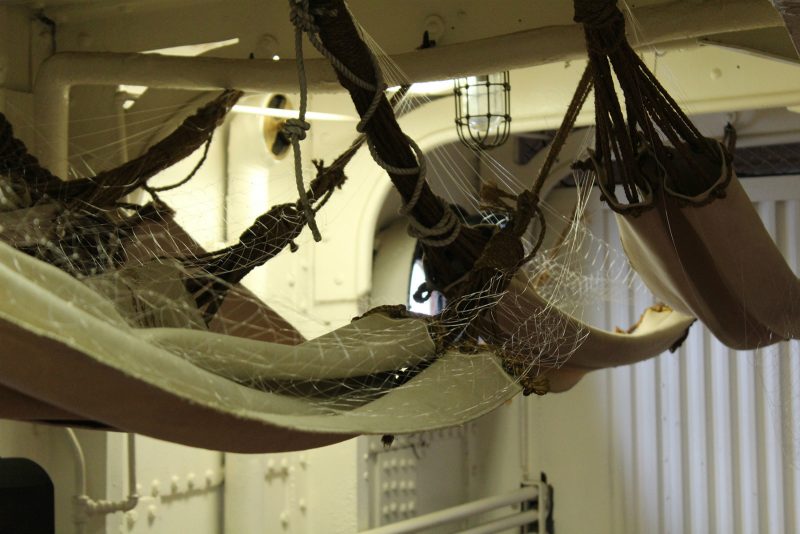
Dreams of empire, dreams of home
The deceptively simple installation by North Carolina-based artist Andi Steele conveys the subtle yet powerful presence of Olympia’s ghosts, the generations of sailors who slept and dreamed in the ships’ hammocks. Using monofilament, Steele constructs delicate “Ghost Hammocks” that hover just above the actual hammocks, which are part of the ship, suggesting the forms of sleeping bodies–even their dreams and thoughts. Together, Clark, Burgess, and Steele focus on the mysterious inner lives of sailors, creating layered and allusive objects that speak to the specific context of Olympia, but which also manage to resonate beyond its confines.

On the upper deck, Jacintha Clark filled the Captain’s Office with a host of individual porcelain objects, replicas of the sorts of navigational tools, maps, charts, and papers that were used before the era of GPS and electronic devices. Each piece in “Wrinkled Blue” is lovingly rendered, the product of hours of research in the museum’s archives. The delicate porcelain elevates mundane tools into objects of beauty, and transforms the ephemera of daily life into monuments to a lost age of seafaring and navigation.
Philadelphia Sculptors has assembled engaging work by a diverse group of artists that includes, in addition to those mentioned in this review, Nadia Hironaka and Matthew Suib, Elizabeth Mackie, Mary Mattingly, Kevin Blythe Sampson, Joanna Platt and Nathan Solomon, Gerard Brown, William Chambers, Cheryl Harper, Sarah Kabot, Carrie Mae Smith, and Joan Menapace.
Mounting an exhibition in this unconventional setting, with the restrictions imposed both by the space itself as well as the necessities of conservation, is a complicated undertaking. While some works felt limited by their exclusive focus on the nautical theme, the most successful and engaging works managed to speak to their surroundings and transcend them.
Artship Olympia is on view until October 2, 2016. Access is free after admission to Independence Seaport Museum, 211 S. Columbus Blvd. Philadelphia, PA 19106. Open daily 10 am–5 pm. Historic ships open until 8 p.m. on Thursday, Friday, and Saturday.


